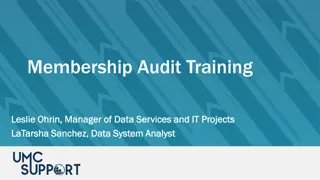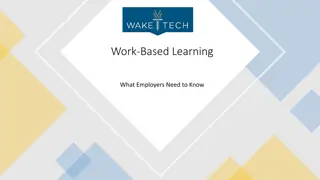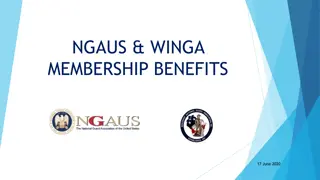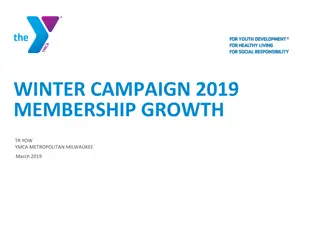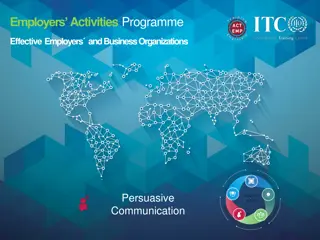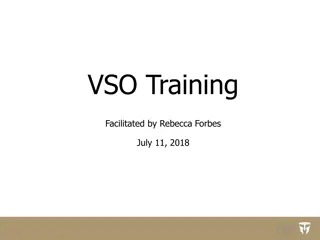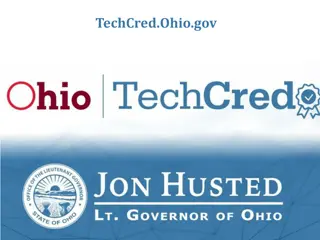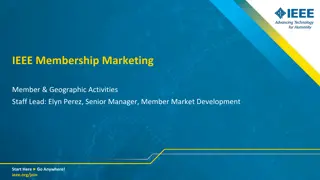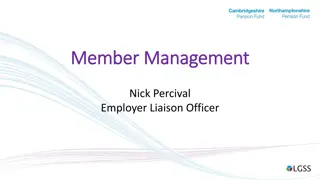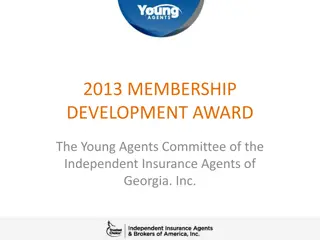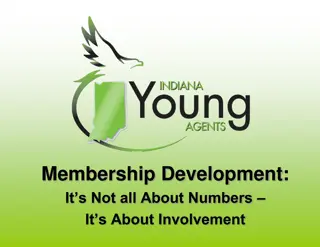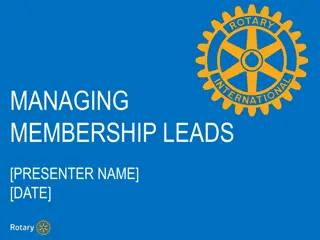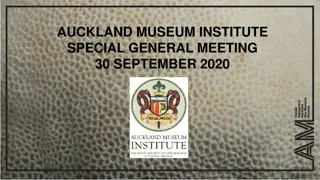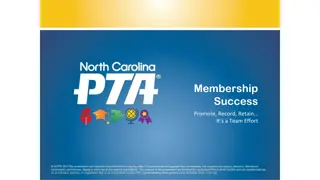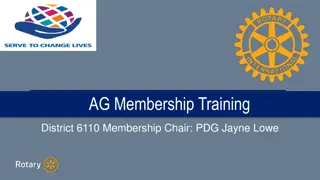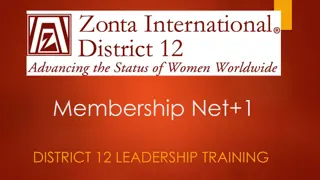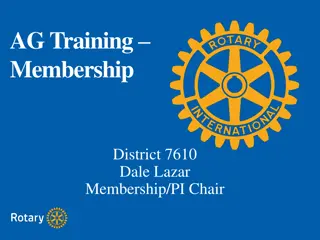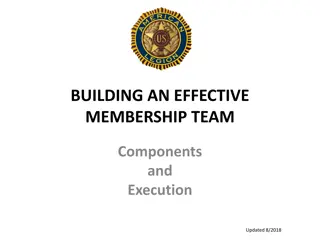Membership Strategies for Effective Employers and Business Organizations
Tailor-made guide on membership strategies for Employers and Business Member Organizations (EBMOs) emphasizing the importance of attracting and retaining members to ensure sustainability and influence. Key points include defining value proposition, understanding membership situation, and maximizing membership cycle.
Download Presentation

Please find below an Image/Link to download the presentation.
The content on the website is provided AS IS for your information and personal use only. It may not be sold, licensed, or shared on other websites without obtaining consent from the author.If you encounter any issues during the download, it is possible that the publisher has removed the file from their server.
You are allowed to download the files provided on this website for personal or commercial use, subject to the condition that they are used lawfully. All files are the property of their respective owners.
The content on the website is provided AS IS for your information and personal use only. It may not be sold, licensed, or shared on other websites without obtaining consent from the author.
E N D
Presentation Transcript
Employers Activities Programme Effective Employers and Business Organizations Membership strategy 1
Membership Strategies Tailor-made Guide on Membership strategies for EBMOs - Employers and Business Member Organizations Final version to be published end 2018 Draft available on http://lempnet.itcilo.org 2
Importance of Membership Employers and Business Member Organizations (EBMOs) are MEMBERSHIP Organizations EBMOs exist to represent their members interests. They do so in an independent way, Members are free to join. [ILO Convention No 87 on Freedom of Association] 3
Importance of Membership In other words: Without members, there is no EBMO! EBMOs need to attract new members and retain existing ones They need to add value to companies and association members on an on-going basis to ensure their sustainability (not just when figures get low!!) 4
The issues around membership Further growth and influence More resources Increasing membership High representativeness High quality services More resources High membership 5
The issues around membership Membership low Limited resources Limited services Low influence More limited membership Lower resources More limited services 6
Membership strategies Membership strategies are essential to EBMOs. Membership strategies exist to ensure two things: Revenue resources Representativeness - influence Without resources nor influence, EBMOs cannot exist 7
Membership strategies Even if Membership Strategies are unique to each EBMO, all organizations need to: 1. Identify what is being offered to members (in other terms: define the EBMO s value proposition), 2. Know the current membership situation, 3. Maximize on membership cycle. 8
1. Define the Value Proposition Why and How does the EBMO solve your problem? Relevance Quantified Value What specific benefits does the EBMO bring? Unique differentiation Why can you get the benefits only through this EBMO? 9
1. Define the Value Proposition The EBMO s value proposition is A marketing tool, Easily available and understandable, Very concrete. Remember: belonging to a Club of peers can be a powerful attraction factor for membership. It is important to recognize it and use it for recruitment and retention (continued engagement). 10
2. Know the situation At all times, it is essential to have a good understanding of The current membership levels, The reasons explaining the data. Formulating Key Performing Indicators (KPIs) on Membership; Having a system to record interactions with members and Collecting both qualitative and quantitative data are a MUST for professional EBMOs. 11
2. Know the situation Remember: what gets measured, gets done! EBMOs need to set Key performance indicators (KPI) for their membership strategies. Examples are: Representativeness N members, % Members paying subscription fees Number of members per sector / size N of employed workers by members / Total n of employed Turnover achieved by members /Total GDP region or district Intensity % Members using services Relevance Recruitment rate - Retention rate average loyalty 12
2. Know the situation Recording interactions with members is key what happens in many cases is: Data on members listed in Excel file: mostly only names and addresses Different sources where information about members is stored Limited possibility for analysis and reporting Labour intensive to update (often not done regularly) Static : no linkages can be discovered 13
2. Know the situation Using a CRM (Customer Relation Management) Software will help your EBMO have a professional relation will members. What does CRM add to Membership strategy? What does CRM offer? Good basic data (How many members: total / retained / new; Which characteristics: size; region, sector; Payment status) Good monitoring data : how do clients use the EO Shared data (all colleagues can have access at once and help update) Data on potential clients new potential members Needs oriented / customer focus Segmentation Creation of long lasting contacts and loyalty Close monitoring of results SUPPORTED BY IT! Learn more on the ITCILO CRM project and the 60+ EBMOs using the software on lempnet.itcilo.org 14
2. Know the situation The top 5 challenges for recruiting and retaining members are: Perceived lack of value 1 Too expensive 2 Forgot to renew 3 4 Not aware of EBMO s offer Not involved 5 15
2. Know the situation Regular collection of both qualitative and quantitative data through surveys will help your EBMO understand the underlying causes for recruitment and retention challenges and give you the tools to address them Examples include: Satisfaction surveys; Needs survey for all membership or segments (SMEs, etc.); Exit surveys (for lapse members) etc. 16
3. Maximizing on Membership Cycle There are five components to the membership cycle: 1. Awareness 2. Recruitment 3. Engagement 4. Renewal 5. Reinstatement 17
3. Maximizing on Membership Cycle The membership cycle can be a useful tool to Better understand the membership dynamics from the point of view of a member; Review current EBMO practices, identify missing elements and develop remediation strategies. 18
3. Maximizing on Membership Cycle What does the membership cycle means for EBMOs: 19
3. Maximizing on Membership Cycle All EBMOs conduct membership recruitment activities but what happens in many cases is that it is done in an ad hoc or piece meal approach; From the activities you are conducting, Which ones respond to which phase of the membership cycle? On which phase have you concentrated your efforts? Which phase has been underserved? 20
3. Maximizing on Membership Cycle The aim of awareness-raising is two-fold: to ensure potential members are aware of the EBMO and what it does and for the EBMO to be aware of the changing needs of members and potential members. Is the Value Proposition of the EBMO formulated and communicated in an efficient way? 21
3. Maximizing on Membership Cycle Where should recruitment efforts of the EBMO focus? Identify priority segments to conduct penetration analysis Can the EBMO rely on a broad base of members? Can the EBMO rely on segments of the economy having the most weight (GDP)? Are the emerging sectors in membership? Map membership segments to identify if important ones are missed (SMEs? Informal?) In areas of strong membership what can we do to attract free riders? In areas of poor membership are we responding adequately to needs? 22
Examples of recruitment tools: EBMO s ambassadors (peer to peer) Information events Company visits Road shows Advertisement on radio, TV, newspaper Letters with brochures Calls Social media Collaboration with business promotion agencies New Members Info Pack Emails Website 23
3. Maximizing on Membership Cycle Retention of existing members is even more important (and way cheaper) than recruiting new members The Key is to keep members engaged! How? By knowing why they join; By acknowledging (publicly) their joining, their contribution to the EBMO s work, their success; By keeping them informed and encouraging them to ACT ie. give their views / comments / inputs on matters of their interest (social media can help); participate to meetings and events etc.; By responding to their needs (segmentation) and making clear what the concrete value add of activities you organize is; By measuring engagement and communicating on achievements. 24
3. Maximizing on Membership Cycle Subscription renewal should be a straightforward process. EBMOs should show professionalism by sending invoices on time and clearly communicate deadlines (A CRM software is useful in that respect). Incentives for swift or early renewals can be put in place. Non payment of subscriptions should be acted upon in line with rules laid out in the Constitution. Remember: in the real world, nobody can buy a good or service for free! Important for the EBMO is to use the renewal period to communicate on achievements in general as well as individually for each member (what did YOU get out of the membership to our organization ) The process to fix the level of subscription payments should be open and transparent. Also crucial is to be clear on: What services are comprised in the membership package covered by the annual subscription fee; What is not comprised and is available for an extra fee (price for members vs price for non-members). Exit surveys with members deciding not to renew their membership are very important to improve future retention and reinstatement efforts. 25
3. Maximizing on Membership Cycle Former members may be good potential members; Depending on the reasons for leaving, contacts can be kept in order to assess if circumstances are again favorable for membership; In any case, clarity on conditions for new membership need to be clear. 26
We are a solid and reliable partner in the delivery of training for Business Member Organizations and we look forward to assist you in the implementation of your training needs For further information, please contact: Programme for Employers Activities E-mail: actempturin@itcilo.org Phone: +39 011 693 6590 http://lempnet.itcilo.org 27



